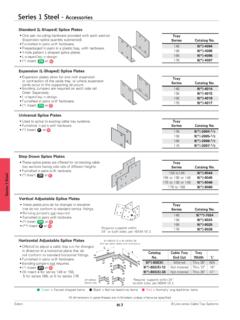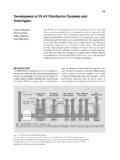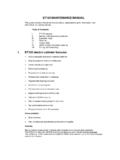Transcription of SMAC Actuators User Manual
1 SMAC The ability to do work and verify its accuracy SMAC-MCA Actuators user Manual SMAC 5807 Van Allen Way Carlsbad California 92008 USA SMAC Europe Limited Tel 01403 276488 Fax 01403 256266 Revision SMAC-MCA 2 SMAC-MCA 3 Contents Description Page actuator Working Principals .. 3 Installation Guide .. 5 Notes for operation .. 7 Precautions .. 8 Grounding and Shielding Advice .. 9 Using SMAC Amplifiers .. 10 Appendix .. 13 Part 2 Configuring your computer .. 22 Setup instructions .. 23 Controller Parameters .. 24 PID values .. 25 Registers .. 26 Programmers Notes .. 27 Sample program .. 32 Input / Output Channels .. 38 SMAC-MCA 4 SMAC-MCA 5 actuator Working Principles actuator Components Moving Coil .. Powers linear motion Linear guide .. Guides linear motion Bumpers .. Adjustable end stops Limit Switch .. End of stroke sensors Thermistor .. Detects overheating Piston.
2 Carries coil, rod and DC motor. Mounted to linear bearing Bearing/Bushing .. Guides rod through body Optical encoder .. Measures distance travelled by piston Glass Scale .. Optical encoder scale Encoder detector head .. Reads the optical scale Index line .. Locates a fixed position on the scale DC motor .. Rotates the rod Gearbox .. Connects motor to rod Rotary encoder .. Measures angular distance traveled Rotary index .. Locates a fixed position on the scale Rotary Coarse Index .. Proximity switch to detect rotary home Method of operation Linear Motion The piston rides on a linear bearing carriage, which slides on the linear guide rail. A copper coil is mounted on the piston. This coil rides inside a magnet assembly. When current flows in the coil, a reaction force is produced causing the piston to slide along the guide. Bumpers are set at each end of the travel to cushion any impact force that may occur. Flags carried by the piston activate limit switches before the end of travel is reached.
3 Either the glass scale of the optical encoder or the reader head is carried by the piston. As the piston moves, the detector head reads the distance travelled. An index line on the glass scale is used as a home location. The actuator rod exits the body through the bearing to maintain alignment. A thermistor is present in the actuator to signal an overheating condition. SMAC-MCA 6 Rotary Motion (LAR series only) An assembly comprising a rotary DC motor, magnetic encoder and gearbox is carried by the piston to rotate the rod. The rod is mounted to the piston in a rotary bearing. The rod and gearbox shaft are connected using a flexible coupling. To locate a home position for the rotary axis, the actuator rod carries a flag. This flag is sensed by a reflective proximity switch and is identified as the coarse index. 25 PIN D CONNECTORMAIN CONNECTOR BOARDLIMIT SWITCHESENCODER READER HEADGLASS SCALEMOUNTINGRIBBON CABLEDC ROTARY MOTORGEARBOXFLEX COUPLINGVACUUM TUBEO-RING SEALSCOARSE HOME FLAGSHAFTCOARSE HOME SENSORMAGNET HOUSINGMOVING COILTHERMISTOR Fig 1.
4 actuator Components (LAR30-15 shown) SMAC equipment required to run a system Linear actuator only: Linear / Rotary actuator : LAL series actuator LAR series actuator LAC 1 Controller LAC 25 controller LAH-LO(D)-03 Cable LAH-RT(D)-03 cable Other equipment required RS232 cable and connector (appendix page 1) Laptop PC or text editor to construct program (see setup instructions) 26 pin I/O connector for Input/ Output channels Either 24 Volt , 4 Amp Power supply (30, 37, 50 series) Or 48 Volt , 4 Amp Power supply (90, 300 series) SMAC-MCA 7 Installation Guide Note: Customers manufacturing their own cables please refer to page 7 of this Manual for advice on shielding and grounding. The actuator must be mounted using the tapped mounting holes provided, and users must ensure that mounting surfaces are flat in order to prevent any distorting of the body when the unit is tightened down (see Figure 2). RAISED MOUNTING SURFACERAISED MOUNTING SURFACETAPPED HOLES AND DOWEL POINTSTAPPED HOLES AND DOWEL POINTS Fig 2.
5 actuator Mounting Points If attaching anything to the rod of the actuator using the threaded part of the rod, use the spanner flats provided to prevent the rod rotating. Do this with the rotary motor powered off as damage may be caused to the gearbox if it is overloaded (turned with the power on). 2x FLATS Fig 3. Use spanner flats The actuator housing and controller housing should both be connected to the same grounding point (Earth). This is usually the case when the units are screwed directly onto a machine chassis. If they are not screw mounted then a ground wire should be attached to each of the units and this should be connected to Earth. As these are anodized it may be necessary to attach the wire to one of the steel screws, or to put a small scratch on the housing to ensure a good connection. It is possible to connect the components to different ground points, but they SMAC-MCA 8 must be at the same voltage level. Failure to do this may cause a current to flow from one point to another and this may result in noise.
6 AC power usually generates the operating voltage ( 24v) which is DC and is isolated (not connected to earth). The power supply has two terminals, 24v and 0v. This operating voltage is used to generate a 5v DC reference voltage. This also has two terminals 5v and 0v. These two 0v terminals are connected together but still isolated from earth. The system will work if these are not connected to earth but problems may arise when the RS232 is connected. The RS232 ground is connected to the 0v connection in the controller. When it is connected to a PC, the ground wire is then connected to earth. If this causes problems the following actions will help: - Plug the power supply to the same AC outlet as the PC - Connect the 0v terminal to Earth Note - the 0 volt terminal of the controller is connected to the metal shield of the connector. As this is screwed into the controller housing, the 0 volt is then effectively connected to Earth when the controller housing is earthed.
7 Therefore it is not usual to see a problem when connecting a PC to the controller. +24 VRTNRS232 CONTROLLERFig 3. Grounding layout SMAC-MCA 9 Notes for installation and operation If the actuator is in a vertical plane without a return spring fitted, the rod will drop if power to the unit is lost. Users must be aware of this as it may damage the end effector being used and also will affect Emergency Stop procedures and re-set sequences. All units must be operated with a 40% maximum duty cycle, this can be calculated as follows: % of max force applied x % of cycle time it is applied = % duty cycle 100% force x 40% of cycle time = 40 % duty 60% force x 50% of cycle time = 30 % duty 40% force x 100% of cycle time = 40 % duty Recommendations from SMAC are that this duty cycle must not be exceeded over a one second time period. NOTE: Failure to observe this duty cycle recommendation will usually result in the actuator sustaining damage through overloading.
8 Overloading will overheat the coil and may cause it to deform and touch on the magnet housing. If the actuator is in vertical plane with no spring return, it will use a certain amount of power just to hold its position. If the payload is excessive, this alone could be enough to exceed the duty cycle. Laws of physics state that : Force = Mass x Acceleration The actuator has a low moving mass, therefore with constant force applied and no load, a large acceleration will result. This will drive the rod into the endstop on the actuator and may cause damage if it is repeatedly done. The actuator is a precision piece of equipment in terms of both force and position. Alignment of the linear axis components must be maintained to ensure smooth running of the rod. To ensure it remains functioning in the correct manner it is advisable to follow the guidelines. SMAC-MCA 10 Precautions: Handle the actuator carefully, do not drop it or subject it to excessive shock loading Do not apply excessive side loads to the rod, this can lead to increased friction and wear on the internal components Avoid putting the actuator in hazardous environments such as wet, dusty, very hot (>50 C), very cold (<0 C).
9 Consult SMAC if the actuator is required to work in these environments. Other points to note: - Use the optical index to home the actuator on a regular basis, this is especially important when the actuator is being moved around on another axis, or subject to vibration. - Avoid powering the rod into the endstops (this is also related to duty cycle) - Get familiar with the actuator by first using it on a horizontal surface with no load and limited force SMAC-MCA 11 Shielding and grounding advice (for customers manufacturing their own cable) Note: Using non-SMAC cables will invalidate the warranty unless the cable is checked by an SMAC engineer. Shielding Noise from wires carrying the coil power needs to be prevented from leaking out these wires need to be twisted pairs held inside a shielded cable. Encoder signals need to be shielded from noise these should also be twisted pairs held inside a separate shielded cable. The shield should cover as much of the wire it is shielding as possible.
10 This means that the encoder signals shield should start as close to the encoder detector circuit as possible and terminate as close to the controller connector as possible. The shield for the coil power lines should follow the same pattern. The shield must therefore cover the whole distance between actuator and controller. For the shields to work they must be connected to a noise free connection, the closer this is to the input the better. This means that for the encoder signal cable the shield should be connected to the 0v terminal of the operating voltage at the controller connector. The power cable shield should be connected to the actuator ground (Earth). Drawings are available on request from SMAC. SMAC-MCA 12 Use of SMAC Amplifiers The SMAC amplifier is intended for use in conjunction with generic servo controllers. The amplifier runs from an 11-50 Volt DC power supply, dependent on the actuator being used. In order to achieve maximum power from the largest units (LAL90, LAL300), a 48V, 5 Amp DC supply is required, otherwise 24V, 5 Amp DC is used.






